BIGGEST DISASTER IN MOTOCROSS HISTORY: THE STORY BEHIND THE CANNONDALE
By Jody Weisel
Hype! Hoopla! Ballyhoo! You name it and Cannondale was accused of it. Believe it or not, it has been over 20 years since the Cannondale Bicycle Corporation released the first photos of its prototype, American-made, four-stroke motocrosser. We can date the arrival of Cannondale’s motocross effort by the date of the first flurry of press releases; however, the release date of an actual race-ready Cannondale MX400 was constantly being pushed back. Originally, Cannondale announced that the bike would be in showrooms in early ’99. That date was changed to the summer of ’99, and after summer passed, there were no more pronouncements from the factory. The bike finally hit the showrooms as a 2001 model.
The Cannondale was billed as the Great American Motocross Hope — a made-in-the-USA motocross bike that would rival the best of Japan and Europe. By no means would Cannondale be the first Great American Motocross Hope. The names Rokon, Harley-Davidson, Ammex, Cooper and ATK may ring bells. Rokon’s great American motocrosser was made in Rhode Island with a German Sachs snowmobile engine powering it. It only lasted a couple years before Rokon folded the motocross division and returned to making two-wheel-drive hunting bikes. Harley’s great American motocrosser was made in Italy at the Aermacchhi factory. Harley tried twice, in 1975 and 1978, but neither bike lasted for more than one year. Ammex was owned by four-time AMA National Champion Gary Jones. The bikes were made in Mexico at the Moto-Islo factory and built on the bones of the failed Cooper brand owned by Maico importer Frank Cooper. Horst Leitner’s ATK was the most successful American motorcycle company—building both two-strokes and high-end four-strokes, but like every company before them, ATK relied on foreign engines. ATKs were powered by Austrian Rotax engines.
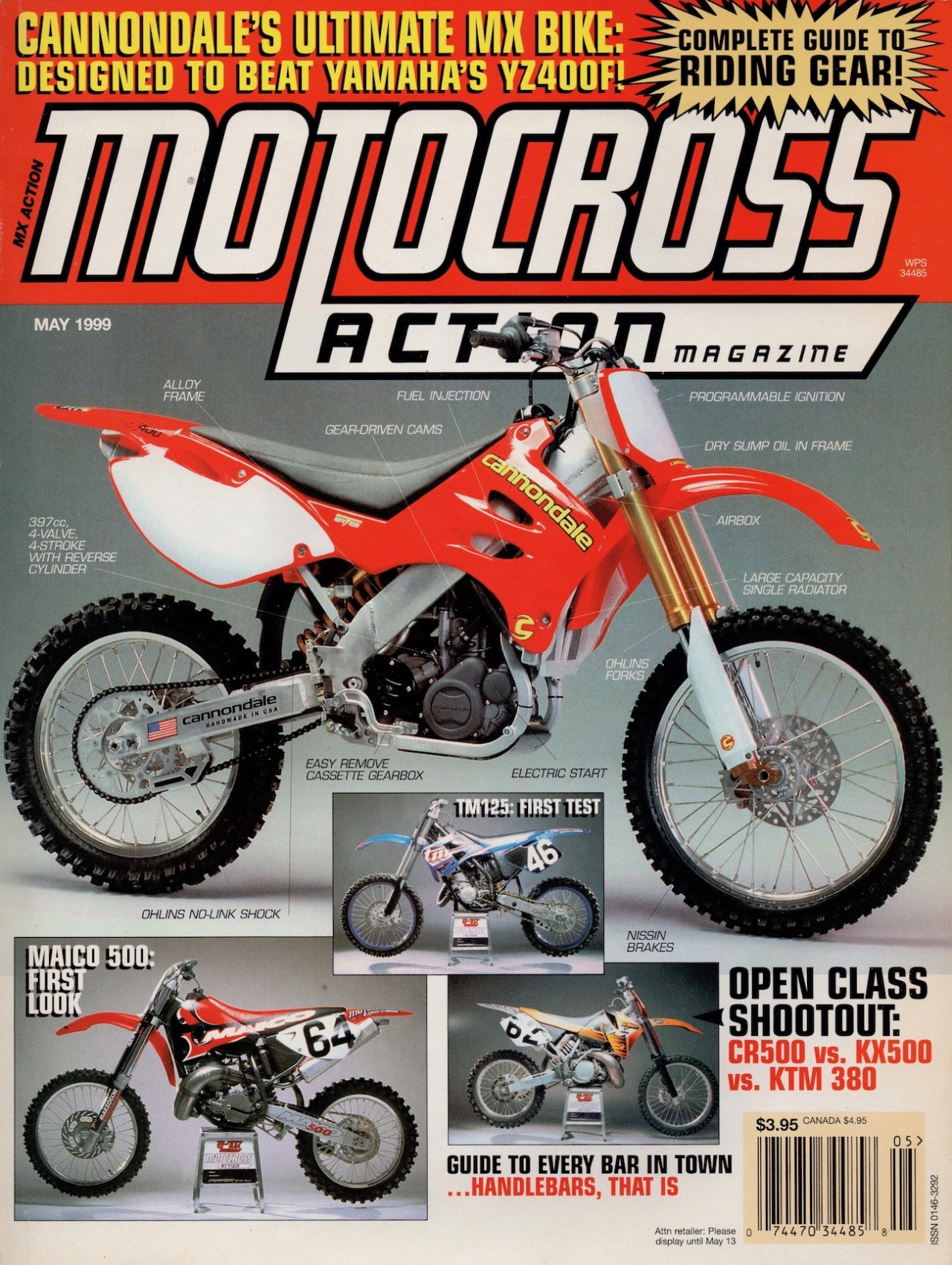 The Cannondale prototype was on MXA’s cover in May 1999. The production MX400 was shown, but not sold until 2001.
The Cannondale prototype was on MXA’s cover in May 1999. The production MX400 was shown, but not sold until 2001.
Back in 1998, Cannondale began a media blitz touting its plans to build an American-made motocross bike. Cannondale even hit the prestigious Cincinnati Motorcycle Dealer show with flashy red and black prototypes (and started taking dealer orders). It took almost three years before those orders could be filled. It was a frustrating time for Cannondale and the motorcycling public, as the bike was delayed time and time again. A large part of the holdup was that Cannondale wanted its bike to be loaded with innovations. Thus, Cannondale’s engineers threw away the original Swedish-built, single-cylinder, 450cc Folan engine that they had started with and had a purpose-built four-stroke engine designed just for them in North Carolina. Cannondale was bit by the innovation bug—and once they got the fever, they couldn’t stop innovating. Every innovation cost them valuable time.
CANNONDALE CAME UP WITH IDEAS THAT ALMOST ANY REAL MOTORCYCLE DESIGNER WOULD HAVE SHOT DOWN IN 30 SECONDS. MOST OF CANNONDALE’S BUZZ WORD STUFF DIDN’T FUNCTION VERY WELL.
The idea of an innovative, American-made, fuel-injected thumper generated tremendous interest for seven obvious reasons:
(1) Motorcycle manufacturers are a tight-knit group, and Cannondale was not a member of that group. This new upstart would be the first major motorcycle manufacturer to join the motocross fray since KTM 25 years earlier.
(2) The Cannondale MX400 would be the first American-built motocross bike since ATK’s Horst Leitner began making bikes in 1982.
(3) During this period of time, the 1998 Yamaha YZ400 four-stroke had paved the way for a new generation of four-stroke motocross bikes.
(4) The Cannondale MX400 was loaded with innovations, including fuel injection, electric start, a backwards cylinder, bolt-together frame and head tube air intake. Looking back at the 2001 Cannondale MX400, it is obvious that there is a fine line between gimmicks and innovations. Cannondale came up with ideas that almost any real motorcycle designer would have shot down in 30 seconds—or at the very least, taken the time to figure out how to make them work properly. Most of Cannondale’s buzz word stuff didn’t function very well.
(5) Cannondale’s aluminum frame was touted as being based on the company’s two decades of aluminum expertise (with its successful bicycle brand). Unfortunately, by using the 1997 Honda CR250 frame as the bike’s starting point, Cannondale’s engineers made a huge mistake. The 1997 Honda Delta-Box frame was atrocious.
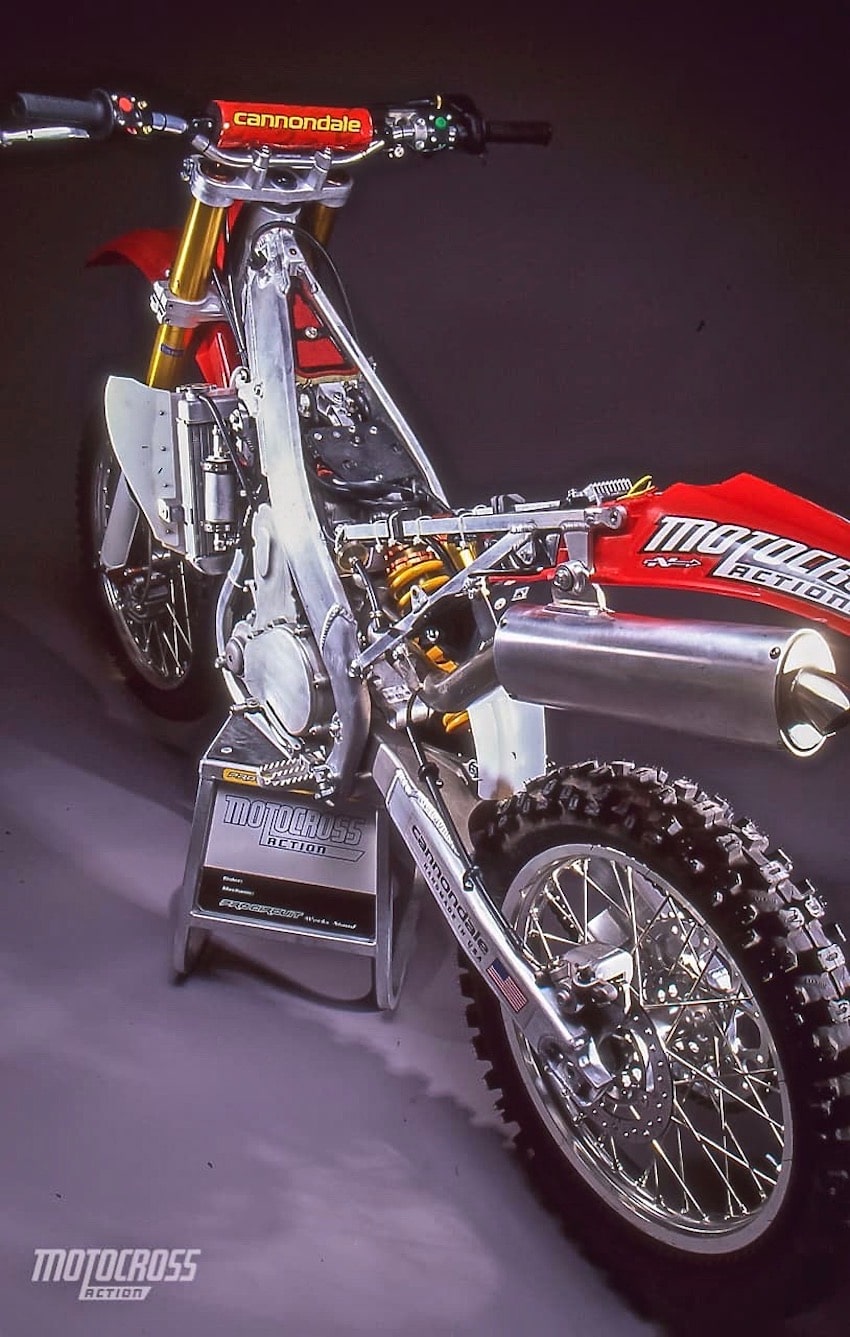
The Honda-clone frame left very little room for the rear-facing exhaust pipe.
(6) At this juncture, it looked like the Environmental Protection Agency (EPA) was closing in on the emissions of off-road motorcycles and focusing on two-strokes specifically. Thus, the four-stroke rush was on. Four-strokes were accurately predicted to be the bikes of the future (based on the idea that the EPA would outlaw two-stroke motocross bikes). However, the EPA didn’t crack down on off-road two-strokes, but out of fear the manufacturers hopped on the four-stroke bandwagon. As for Cannondale, its timing looked fortuitous. Cannondale was on the cusp of a movement.
(7) The dream of an American-made motocross bike has often led to the public and the press turning a blind eye to the real facts. The Cannondale MX400 received rave reviews from many motorcycle magazines (remember when Dirt Rider named it the “Bike of the Year”). MXA was the only magazine that told the public, in no uncertain terms, that the 2001 Cannondale MX400 was a poorly designed, ineffective and seriously flawed machine. That was the truth—proven beyond a doubt over time.
IT IS NOT TRUE THAT MXA WAS TO BLAME FOR CANNONDALE’S DEMISE—ONLY THAT CANNONDALE THOUGHT WE WERE. THEY NEEDED TO ACKNOWLEDGE A SERIES OF POOR DECISIONS MADE BY THEIR ENGINEERS, DESIGNERS AND EXECUTIVES.
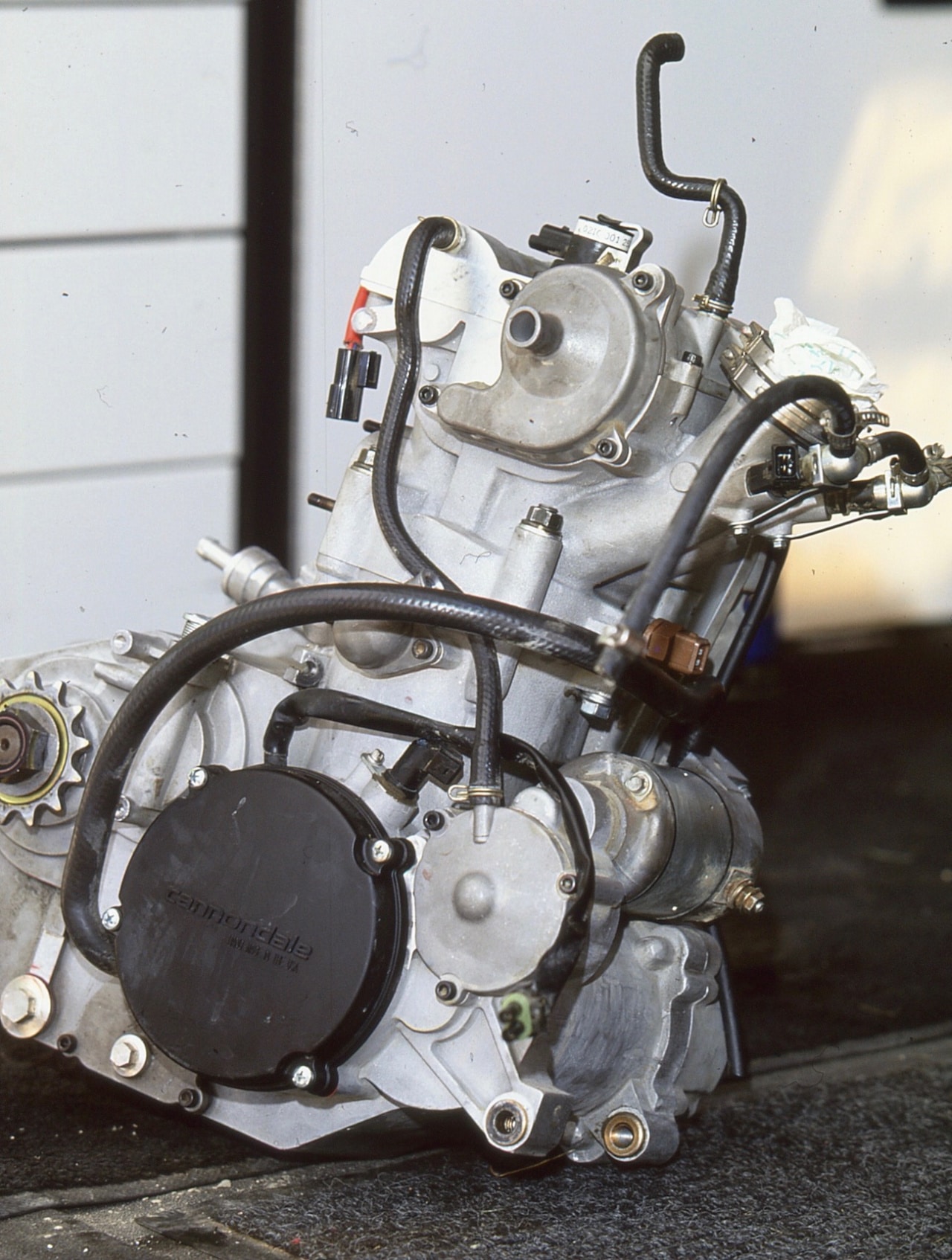 Cannondale’s water-cooled, fuel-injected, electric-start, cassette transmission, reverse cylinder engine was made in America. Had everything worked it would have been a decent engine—albeit one that weighed a ton.
Cannondale’s water-cooled, fuel-injected, electric-start, cassette transmission, reverse cylinder engine was made in America. Had everything worked it would have been a decent engine—albeit one that weighed a ton.
Like its predecessors, Rokon, Harley-Davidson, Ammex, Cooper and ATK, the Cannondale motorcycle company failed—spectacularly (taking the Cannondale bicycle company and the family fortune of its founders with it). When all the bankruptcy papers had been filed, Cannondale CEO Joe Montgomery pointed the finger at MXA’s bike test as the cause of the MX400’s failure. It is not true that MXA was to blame for Cannondale’s demise—only that Cannondale thought we were. They needed to acknowledge a series of poor decisions made by their engineers, designers and executives.
Why did the “Great American Motocross Hope” fail? First and foremost, Cannondale didn’t seek competent help, make good decisions or understand what makes a motorcycle successful. Let’s break it down.
Engine. Cannondale should have stuck with the lightweight, simple, Swedish-built Folan engine, which sprung from the minds of former Husqvarna and Husaberg designers. It would have been a good starting point. With an investment much smaller than what they wasted on their eventual engine choice, Cannondale could have reworked the Folan 450 four-stroke engine into a powerful, reliable and light motocross powerplant. But, they dropped the Folan that powered their original prototypes for a ground-up design that incorporated lots of cutting-edge, but untested concepts. It was not a terrible engine performance-wise, but the packaging was all wrong for a motocross bike.
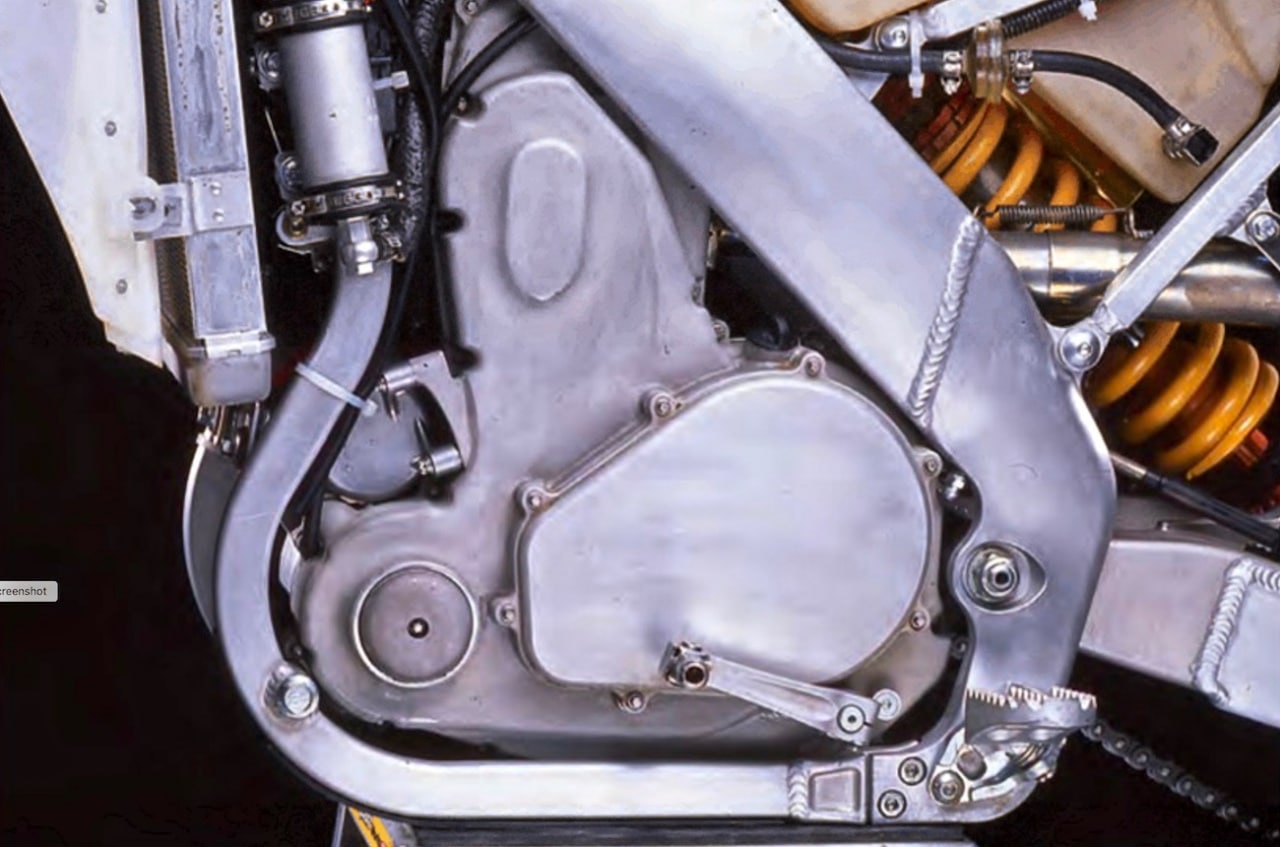 The MX400’s frame had to bulge in the front to make room for the electric starter motor, which wouldn’t work when the engine got hot.
The MX400’s frame had to bulge in the front to make room for the electric starter motor, which wouldn’t work when the engine got hot.
Backward cylinder. It is true that Cannondale turned its cylinder around backwards a decade before Yamaha did it in 2010; however, Yamaha understood that the most important thing about a four-stroke exhaust system is its “tuned length.” Cannondale didn’t take tuned length into account, or more than likely discovered after the fact that there was no room for long exhaust pipes in the tight confines of their Honda-inspired frame and overly large backwards engine. In desperation, Cannondale just stuck the exhaust pipes out the back of the cylinder, giving the bike an exhaust system that consisted of a head pipe attached to a muffler. That is not the way to produce power.
Powerband. The MX400 had minimal low-end and no way to get more. It did make good mid-and-up power, but it was not contemporary four-stroke power. MXA stated in the 2001 MX400 test, “The Cannondale MX400’s powerband is more two-stroke than four-stroke. That may sound like blasphemy for a valve-and-cam bike, but it’s the truth. The MX400 is a gun-and-run engine. It has very confused ignition timing off the bottom, and by the time the engine is ready to go, the revs are already in the midrange. To make the most of the MX400, you gas it and go, pick the next gear on the run and go again. You don’t glide, and you can’t depend on low-rpm throttle response. It won’t pick up cleanly off the bottom, so it’s best to stay away from it.”
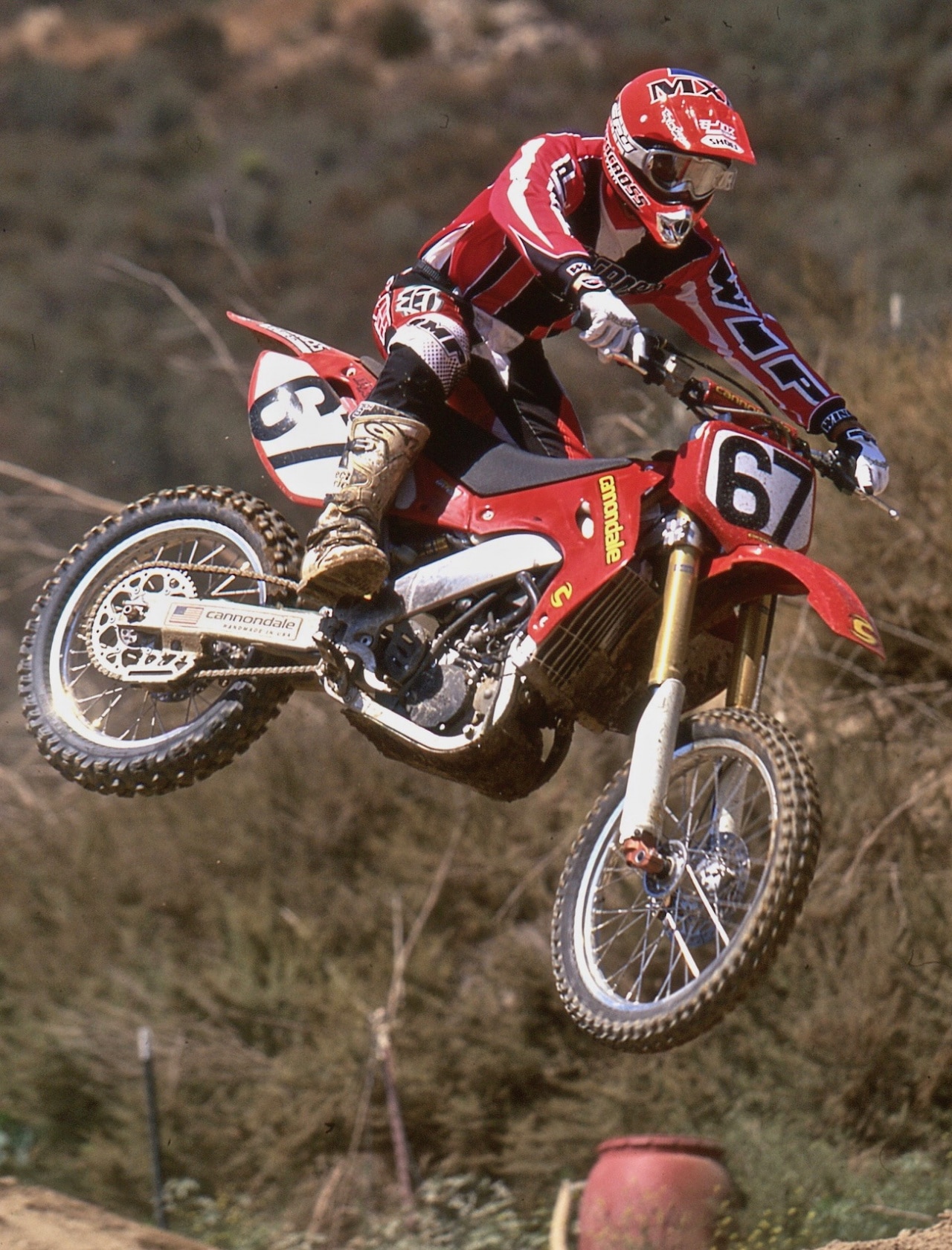 At 260 pounds, the 2001 Cannondale MX400 makes the 223-pound 2021 KTM 450SXF seem like a feather. Given the soft front forks, harsh rear shock and extra weight it didn’t float like a feather.
At 260 pounds, the 2001 Cannondale MX400 makes the 223-pound 2021 KTM 450SXF seem like a feather. Given the soft front forks, harsh rear shock and extra weight it didn’t float like a feather.
Fuel injection. Although ATK had pioneered fuel injection on four-strokes much earlier (most buyers still opted for a carb), Cannondale wanted to be at the forefront. The MX400’s fuel injection was so poorly tuned that the bike would flame out at low rpm, yet idled so fast that you could ride the bike around the pits without touching the throttle (and to turn the idle down, which just aggravated the flameout, you almost had to take the bike apart).
We wished that it had a carb, because the fuel injection worked worse than any carb-equipped four-stroke. To change the jetting, you needed an electronic device that had to be hooked into the fuel system’s SEM microprocessor. Additionally, the Sagem fuel injector was very sensitive to temperature changes. We noticed the need to go leaner between the cool air of practice and the warmer temps of moto two. There was a hole in the ignition mapping that made idling the MX400 through the pits an unpredictable affair. When the bike was running at low rpm, it surged, chugged and lurched as the ignition stumbled around. Even worse, if you punched the throttle the bike would pop and die (flame-out). On the track, this led to stalling on the entrance to tight turns.
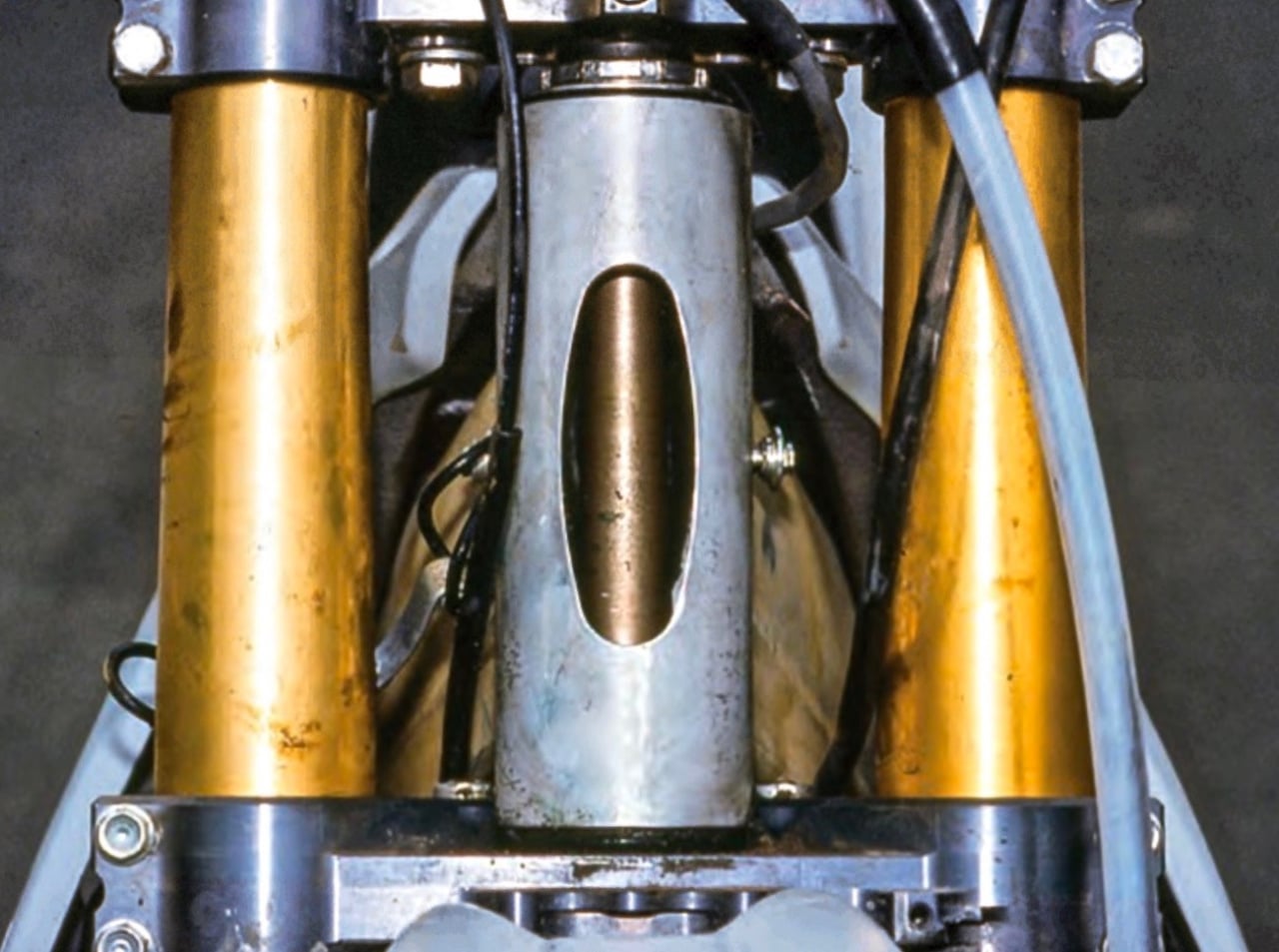 This was where the air for the MX400 entered. That opening was not large enough to provide enough air for a 450cc engine turning 10,000 rpm.
This was where the air for the MX400 entered. That opening was not large enough to provide enough air for a 450cc engine turning 10,000 rpm.
Through-the-frame air intake. This was a bad idea from the very beginning. It should have been shot down in flames before the first blueprint was drawn. Racing engines are little more than air pumps. To make power, engines ingest huge amounts of air for the combustion process. The modern airbox is inadequate, so imagine the shortcomings of trying to draw air from behind the front number plate, through the frame’s downtube and into the engine. In short order, Cannondale was forced to put a second air intake under the gas tank after the MX400 failed to run well enough with one intake. That meant that you had to clean two air filters (and to get to the second air filter, you had to remove the seat, radiator wings and gas tank). Additionally, washing the MX400 could allow water to infiltrate the system unless you used the special Cannondale airbox covers.
Electric start. This was a good idea that Cannondale botched (and left for KTM to get right). The MXA test riders had high expectations for Cannondale’s electric starter because it worked well in the pits when the MX400 engine was cool; however, if you stalled the bike on the track (and with the EFI issues, flame-out was always a possibility) the Cannondale resisted lighting up again.
Suspension. Cannondale went with high-quality Ohlins forks and shocks, but the fork spring rates were so soft that the bike couldn’t be ridden fast. We ran 0.49 kg/mm fork springs instead of the stock 0.47 fork springs. The 0.49s held the front end higher in its stroke, which lessened the MX400‘s tendency to oversteer and dive in corners. On the opposite end of the spectrum, the no-link shock system had a rising-rate leverage ratio that was too aggressive at the end of the stroke and not aggressive enough at the beginning. When paired with Ohlins’ twin-piston PDS shock, the MX400 rode on the stiffer of the two shock pistons, the stiffest part of the leverage ratio and with a spring rate that was too stiff. It had a dead feeling, thumped through braking bumps and seemed locked in one position.
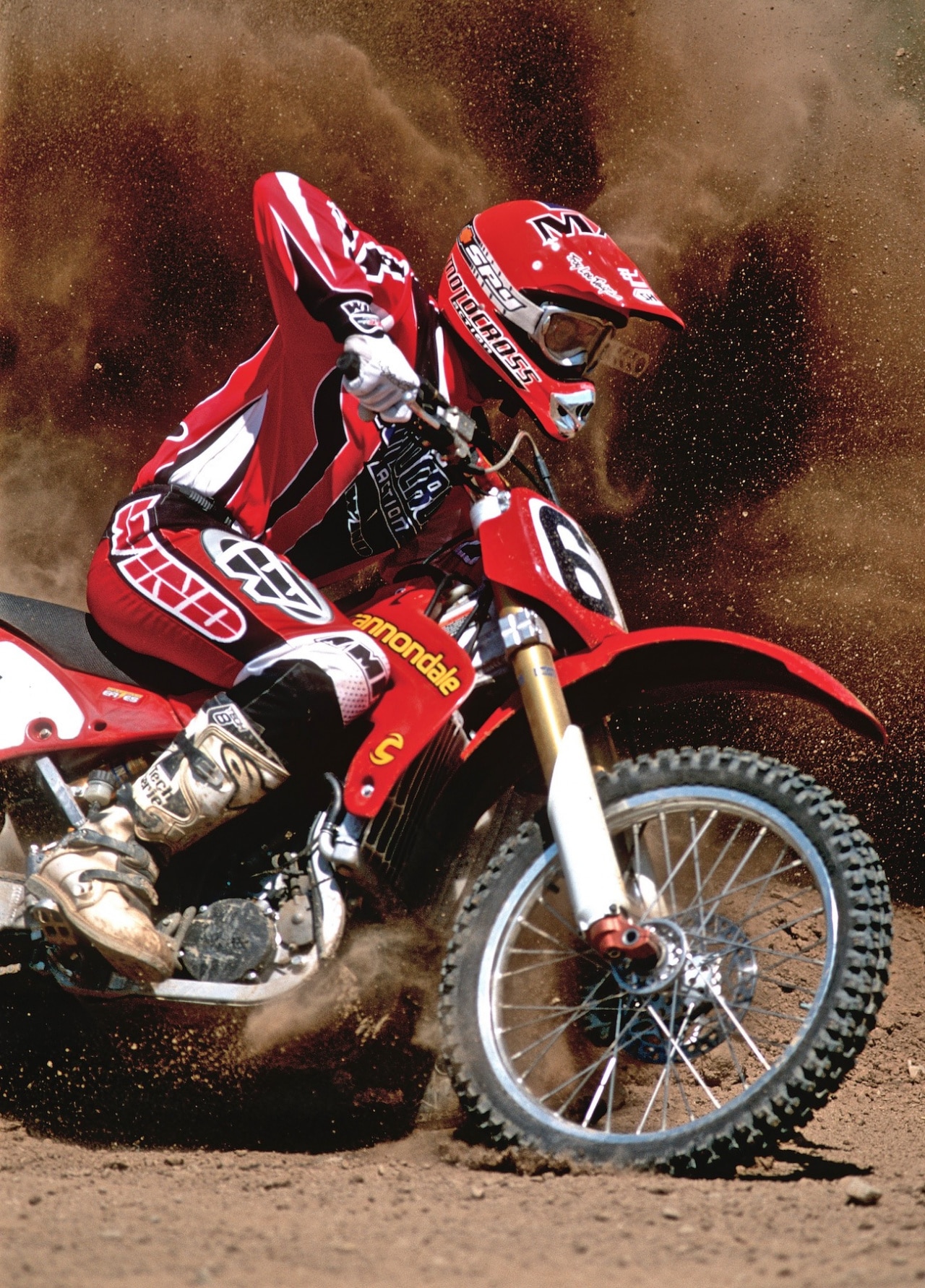 It wasn’t that it didn’t run; it is that it didn’t run for very long.
It wasn’t that it didn’t run; it is that it didn’t run for very long.
Handling. That CR250 frame heritage made the 2001 Cannondale feel like a ’97–’99 Honda. That can be extrapolated to mean that the forks had mid-stroke harshness (caused by the fact that they hung down in their travel), the rear suspension thudded through the bumps (the dead feeling emanating from the aluminum frame), and the front end had an oversteer and push glitch (just like the pre-2000 CRs). The Cannondale inherited a lot of the things that Honda had been criticized for (sort of like a computer virus) and that Honda tried to fix in 2000 and 2001, but Cannondale had already committed to a copy of the earlier Honda chassis.
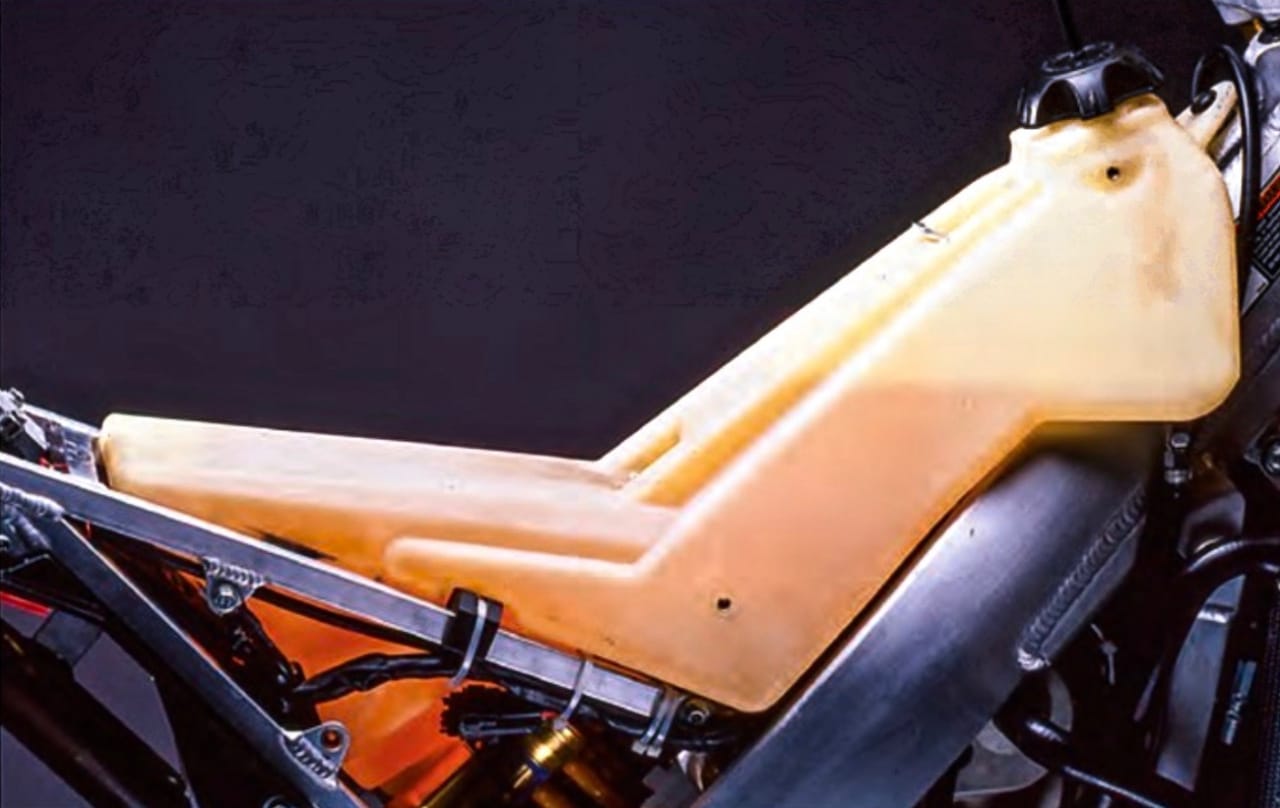 The fuel tank was low and long. Unfortunately, it had to be removed to do some very mundane maintenance tasks.
The fuel tank was low and long. Unfortunately, it had to be removed to do some very mundane maintenance tasks.
Reliability. The MXA wrecking crew went through two engines on the 2001 MX400 in the first week of testing. The first one had a camshaft gear come loose, which allowed the cam to go out of time and the engine to quit. The second MX400 mill had a poorly machined circlip groove on the main shaft that allowed the clutch basket to seek its own destiny (apart from the rest of the mechanism). Additionally, the rear wheels had a tendency to shed spokes.
Worse yet, the bike was impossible to work on. To adjust the idle on the EFI throttle body, you needed a floor jack to lower the whole engine to get access to the front-mounted, down-draft throttle body or to adjust the valves. The first batch of Cannondales was so flawed that when an owner complained, he stood a fairly good chance of getting a brand-new replacement bike from Cannondale for free.
WOULD YOUR DREAM BIKE BE SLOW, HEAVY, COMPLICATED, UNRELIABLE, POORLY SUSPENDED AND POOR HANDLING? WHEN YOU START WITH A BLANK SHEET OF PAPER, THERE IS NO ONE TO BLAME BUT YOURSELF. CANNONDALE NEEDED TO BUY AN ERASER AND START OVER.
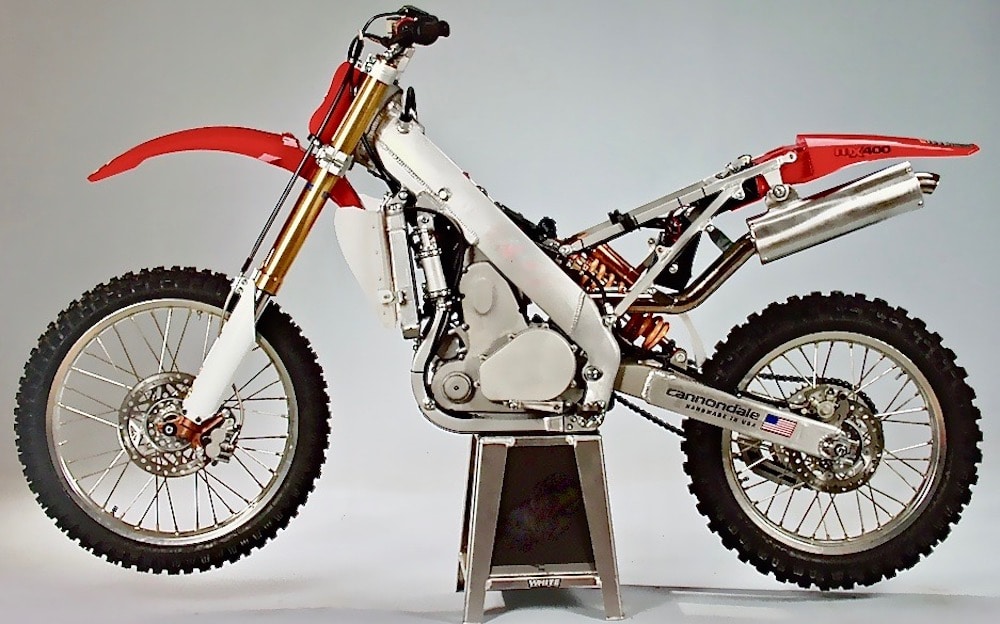
Engine oil was stored in the aluminum frame. We never tried to fry an egg on it, but we fried our arms every time we bumped against the twin spars.
MXA opinion. What did we think of the 2001 Cannondale? Here’s the list: (1) It was better than we thought it would be—we thought it would be horrid. (2) It was faster than we thought it would be, but not as fast as the competition. (3) It was heavier than we thought it would be—about 20 pounds heavier than the YZ426 of the day. (4) It was softer in the front than we thought it would be. (5) It was stiffer in the rear than we thought it would be. (6) It was cobbier than we thought it would be. (7) It was harder to work on than we thought it would be. (8) It was gimmickier than we thought it would be. (9) It was riddled with more innovations that didn’t work than we thought it would have.
In essence, we ended our 2001 Cannondale MX400 test with this blanket statement: “Thanks, but no thanks. Have you ever dreamed of building your own motocross bike? Would your dream bike be slow, heavy, complicated, unreliable, poorly suspended and poor handling? When you start with a blank sheet of paper, there is no one to blame but yourself. Cannondale needs to buy an eraser and start over.”
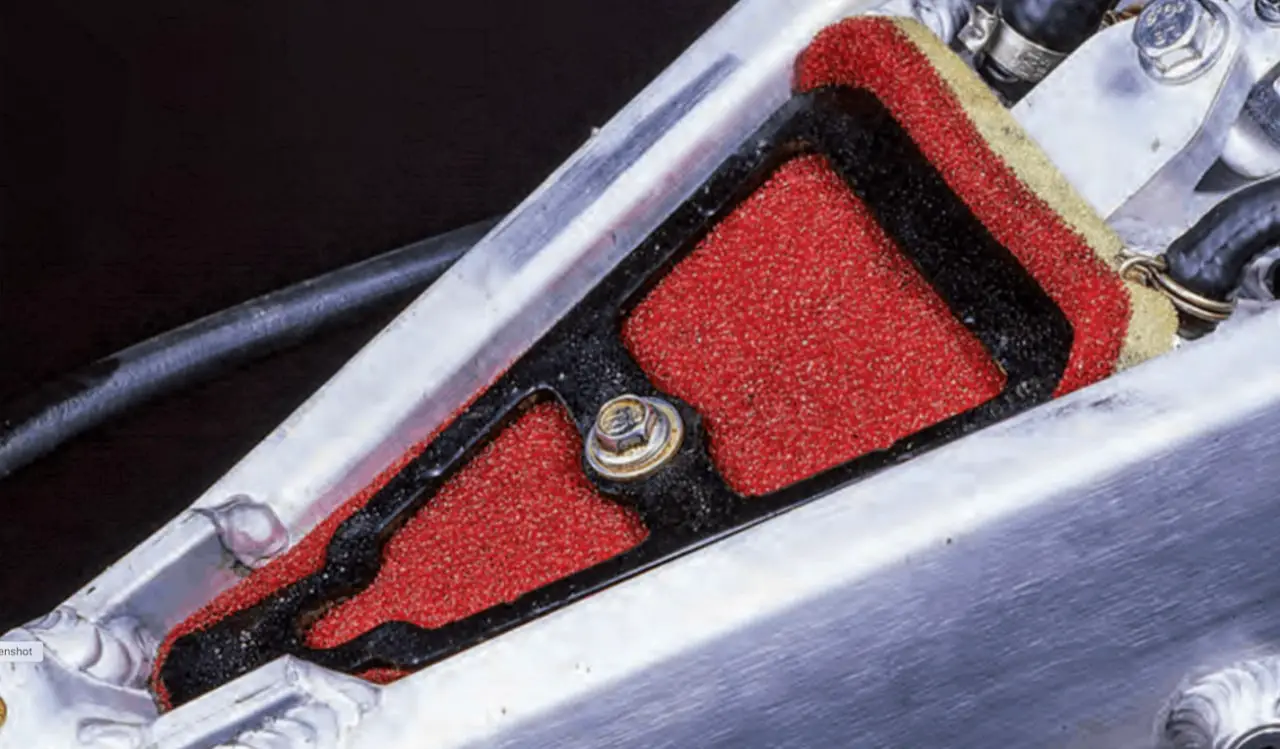
When the front number plate airbox concept failed, a second air filter was put under the gas tank. You had to remove the seat, plastic and gas tank to clean the filter.
But Cannondale didn’t buy an eraser. They couldn’t afford one. In January of 2003, Cannondale filed for Chapter 11 bankruptcy, selling its assets to its main creditors, CIT/Business Credit and Pegasus Partners II. Cannondale ceased motorcycle production and terminated everyone in the factory. In a weird twist, ATK’s owners bought the rights to the engine, mainly for the parts business and to use in any future ATK machines. Cannondale reported a loss of $46,600,000 on the motorcycle and ATV division, after reporting 11 straight quarterly losses. In the year before filing for Chapter 11, Cannondale’s share price on the Nasdaq had fallen 83 percent. In the end, the motorcycle losses brought down the whole company. Although Cannondale bicycles survived, it was taken over by completely different owners. Cannondale’s motorcycle foray cost the company paper wealth that totaled at least $80,000,000.
Scott Montgomery, Cannondale’s director of marketing and son of owner Joe Montgomery, said, “We originally believed that we could build the motorcycle for $20,000,000, but we were way off the mark. One motorcycle company told us that it would cost $100 million and take five years. In the end, they were right. We spent somewhere near $80 million in almost as much time. Had we known that going in, we would have never attempted it.”









Comments are closed.